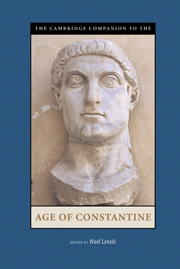Book contents
- Frontmatter
- Introduction
- 1 Sources for the History of Constantine
- Section 1 Politics and Personalities
- Section II Religion and Spiritual Life
- Section III Law and Society
- Section IV Art and Culture
- 11 Perspectives in Art
- 12 Architecture of Empire
- 13 Constantine in Legendary Literature
- Section V Empire and Beyond
- Appendix 1: Stemmata
- Appendix 2: Timeline
- Maps
- Primary Sources and Translations
- Secondary Bibliography
- Index
12 - Architecture of Empire
from Section IV - Art and Culture
Published online by Cambridge University Press: 28 September 2007
- Frontmatter
- Introduction
- 1 Sources for the History of Constantine
- Section 1 Politics and Personalities
- Section II Religion and Spiritual Life
- Section III Law and Society
- Section IV Art and Culture
- 11 Perspectives in Art
- 12 Architecture of Empire
- 13 Constantine in Legendary Literature
- Section V Empire and Beyond
- Appendix 1: Stemmata
- Appendix 2: Timeline
- Maps
- Primary Sources and Translations
- Secondary Bibliography
- Index
Summary
Among the emperor’s vast responsibilities was the duty to build. Every emperor who ruled for more than a short time became responsible for founding or refounding cities, renovating or rebuilding old public buildings, and constructing new ones. Temples, public basilicas, baths, palaces, and mausolea were all objects of imperial patronage with a variety of functions. Constantine followed his predecessors in this regard; indeed, he would surpass most of them. A variety of conditions determined who among the emperors would be great builders. First, the emperor needed the disposition and desire to commit resources to the construction of public and private structures. Some felt this impetus more strongly than others. In addition, an emperor who wanted to build needed the resources of land and money and the willingness to commit these to construction endeavors. The builder also needed a motive, whether to make a political statement, to engage in a heartfelt or public display of piety or largesse, or simply to fulfill the genuine needs of a city or province. Finally, the great builder needed time. Large construction projects often took years to complete, and thus the longer one ruled, the greater the opportunities to build. In Constantine’s case, all of these factors obtained.
Like other great builders, Constantine possessed a desire to leave his mark in various cities of the empire and especially in his two capital cities, Rome and Constantinople. The defeat of his rivals gave him the resources needed to launch numerous construction projects, and his reign of three decades the time to see most of those to completion. He was also motivated by necessity and desire and was involved with projects that had traditionally been a part of imperial patronage, such as public baths.
- Type
- Chapter
- Information
- The Cambridge Companion to the Age of Constantine , pp. 278 - 297Publisher: Cambridge University PressPrint publication year: 2005
- 21
- Cited by



